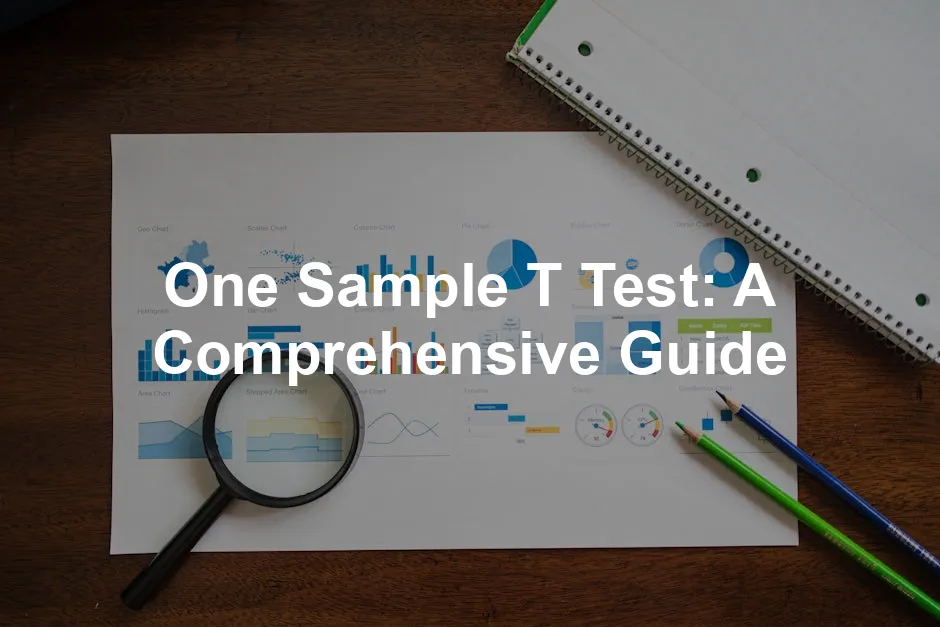What is a One Sample T Test?
The one sample t test is a statistical tool used in hypothesis testing. It compares the mean of a single sample to a predetermined value, often known as the population mean. This test helps determine if the sample mean significantly differs from this hypothesized mean.
To conduct a one sample t test, you first set up two hypotheses. The null hypothesis (H0) states that the sample mean equals the hypothesized population mean. In contrast, the alternative hypothesis (H1) asserts that the sample mean is different from the hypothesized mean.
This test is suitable for continuous data, especially when the sample is drawn randomly from a population. For instance, researchers might use it in a study to see if the average cholesterol level of patients differs from a target value, such as 200 mg/dL.
If you’re diving into the world of statistical analysis, you’ll want to check out Statistical Analysis with R: A Practical Guide to Data Analysis. It’s perfect for those who want a practical approach to understanding data analysis. Think of it as your trusty sidekick in the world of statistics!
The one sample t test is widely used in various fields, including healthcare and social sciences. It allows researchers to validate their assumptions and draw meaningful conclusions from their data. So, when do you think a one sample t test could benefit your research? Consider your own data analysis scenarios!

Assumptions of the One Sample T Test
For the one sample t test to yield valid results, certain assumptions must be met. First, the observations from the sample should be independent of one another. This means that the score or measurement of one subject should not influence another.
Next, the data must be continuous. This requirement ensures that the sample values can take any number within a given range. Additionally, the sample should ideally come from a normally distributed population. While minor deviations from normality may be acceptable, significant departures could render the test invalid.
Lastly, the data should originate from a random sample of the population. This ensures that the sample accurately represents the broader population, leading to more reliable conclusions. If you want to dive deeper into the assumptions of statistical analysis, consider picking up Research Methods in Psychology: Evaluating a World of Information. It’s a great resource for understanding how to evaluate information effectively!
Common violations of these assumptions can affect the test’s outcomes. For example, if the data is not independent or normally distributed, the results may not be trustworthy. Therefore, always check your data against these assumptions before proceeding with a one sample t test. Are your data’s assumptions aligned?

The Formula and Calculation
To calculate the t statistic in a one sample t test, we use the formula:
t = \frac{\bar{x} - \mu}{s/\sqrt{n}}Let’s break down each component of this formula. Here’s what each symbol represents:
– \(\bar{x}\): This is the sample mean, or the average of your data points. It gives us a measure of central tendency for your sample.
– \(\mu\): This represents the population mean, which is the hypothesized value you want to compare against.
– s: This is the sample standard deviation. It measures how spread out the sample data points are around the mean.
– n: This is the sample size, or the number of observations in your sample.
Now, let’s see how this works in practice with a hypothetical example. Imagine you have a sample of five students who scored the following on a test: 78, 82, 85, 90, and 88. If you’re interested in learning more about statistics in the context of data science, check out Practical Statistics for Data Scientists: 50 Essential Concepts. This book offers an accessible introduction to the essential concepts of statistics tailored specifically for data science.
First, calculate the sample mean \(\bar{x}\):
\bar{x} = \frac{78 + 82 + 85 + 90 + 88}{5} = 84.6Next, calculate the sample standard deviation s:
s = \sqrt{\frac{(78-84.6)^2 + (82-84.6)^2 + (85-84.6)^2 + (90-84.6)^2 + (88-84.6)^2}{n-1}} \approx 4.18Assuming the population mean \(\mu\) is 80, and with n = 5, we can now plug these values into our formula:
t = \frac{84.6 - 80}{4.18/\sqrt{5}} \approx 2.66This t statistic tells us how far our sample mean is from the population mean, measured in standard errors. Why not try this with your own data? Calculate the t statistic and see what insights you can uncover!

Interpreting Results
Interpreting the results of a one sample t test is crucial to understanding your data. The two main outputs to focus on are the p-value and confidence intervals. These metrics provide insights into the statistical significance of your findings.
First, let’s talk about p-values. A p-value indicates the probability of observing your sample mean, assuming the null hypothesis is true. If the p-value is less than 0.05, it suggests strong evidence against the null hypothesis. For instance, a p-value of 0.03 indicates that there’s a 3% chance of observing the results if the null hypothesis is correct. Conversely, a p-value above 0.05 suggests insufficient evidence to reject the null hypothesis.
Next, confidence intervals (CIs) offer a range of values that likely contain the true population mean. A 95% confidence interval means that if you were to conduct the test 100 times, 95 of those intervals would contain the true mean. If your CI does not include the hypothesized mean, it further supports your findings. For example, if you’re testing whether the average weight of a sample differs from 50 kg and your CI is (48 kg, 52 kg), it suggests the sample mean is not significantly different from 50 kg.
Interpreting these results in real-world contexts is essential. Suppose a medical study shows that a new drug reduces blood pressure significantly. A low p-value and a confidence interval not including the baseline mean would indicate that the drug is effective. Understanding the differences in practical significance versus statistical significance can further enhance your interpretation. If you’re interested in the intersection of statistics and data science, consider reading The Elements of Statistical Learning: Data Mining, Inference, and Prediction. This book is a great resource for those looking to deepen their understanding of statistical learning.
Understanding the differences between practical significance and statistical significance is crucial for interpreting results accurately. Read more here.
Reflect on your own findings. What do they imply in practical scenarios? Understanding the implications can help guide decisions or future research directions.

Example of One Sample T Test
To illustrate the one sample t test, let’s consider a scenario where a pharmaceutical company tests a new drug intended to lower blood pressure. The goal is to determine if the mean blood pressure of patients taking the drug is significantly different from the known population mean of 120 mmHg.
The researchers gather a sample of 30 patients and measure their blood pressure after treatment. The data collected shows a mean blood pressure of 115 mmHg with a standard deviation of 10 mmHg. If you’re curious about the statistical methods used in psychology, you might want to explore Discovering Statistics Using IBM SPSS Statistics. This book is fantastic for those looking to apply statistical techniques in social science research.
To perform the one sample t test, the researchers first state their hypotheses. The null hypothesis (H0) posits that the mean blood pressure is equal to 120 mmHg. The alternative hypothesis (H1) suggests that the mean differs from this value.
Using the t statistic formula, they calculate the t value:
t = \frac{115 - 120}{10/\sqrt{30}} \approx -2.74Next, they determine the degrees of freedom, which is 29 (30-1). Using a t-distribution table, they find the critical t-value for a two-tailed test at a significance level of 0.05 is approximately ±2.045.
Since –2.74 is less than –2.045, they reject the null hypothesis. Additionally, they calculate a p-value of 0.01, indicating strong evidence against the null hypothesis. If you’re looking to enhance your data analysis skills, you might find The Data Science Handbook: A Guide for Data Scientists to be a valuable resource.
In conclusion, the test suggests that the new drug significantly lowers blood pressure compared to the population mean. This example shows how the one sample t test can provide valuable insights in healthcare research. Think about your own research questions. Could this test apply to your findings?

Limitations of the One Sample T Test
While the one sample t test is a widely used statistical method, it has its limitations. One significant drawback is its sensitivity to outliers. Outliers can skew the results, leading to misleading conclusions. Just a few extreme values can significantly affect the calculated mean and standard deviation.
Another limitation involves the assumption of normality, especially in small sample sizes. If your data doesn’t follow a normal distribution, the results may not be reliable. This is particularly concerning when working with smaller samples, where the central limit theorem might not apply. If you’re interested in biostatistics, you should check out Essentials of Biostatistics in Public Health. This book provides essential concepts for anyone diving into public health statistics.
When these assumptions are violated, consider using non-parametric alternatives like the Wilcoxon signed-rank test. This approach doesn’t require the data to be normally distributed and is robust against outliers. Research has shown that these alternatives can provide more reliable outcomes in certain situations.
A study published in the Journal of Statistics highlights that using the one sample t test on non-normal data can lead to increased Type I error rates. Thus, it’s crucial to check your data for these limitations. Always consider the assumptions before choosing statistical methods for your analysis. For tips on effective data analysis, check out these insights.
Understanding the limitations of the one sample t test can help you choose more reliable statistical methods. Learn more about effective data analysis.

Conclusion
The one sample t test serves as a vital tool in hypothesis testing and data analysis. Understanding its assumptions, calculations, and interpretations is essential for effective usage. By being aware of its limitations, you can apply this test more accurately in your research endeavors. Use the knowledge gained here to make informed decisions in your statistical analyses. If you’re looking for a great way to kickstart your day, consider reading The 5 AM Club: Own Your Morning, Elevate Your Life. It might just transform your approach to productivity!

FAQs
What is a one sample t test?
A one sample t test is a statistical test. It compares the mean of a single sample to a known population mean. This helps determine if the sample mean significantly differs from a specified value.
When should I use a one sample t test?
Use it when you want to compare a sample mean to a known value. This is typically applicable when you only have one sample.
What are the assumptions of the one sample t test?
Assumptions include independence of observations, normal distribution of data, and random sampling from the population. Ensuring these criteria are met is crucial for valid results.
How do I interpret the results of a one sample t test?
Focus on the p-value and confidence interval. A low p-value indicates a significant difference between the sample mean and the hypothesized mean. The confidence interval provides a range that likely contains the true population mean.
Can I use a one sample t test with small sample sizes?
Yes, but ensure the data is approximately normally distributed. If not, consider using a non-parametric test instead.
What is the difference between a one sample t test and a paired t test?
A one sample t test compares one sample to a known value. In contrast, a paired t test compares two related samples, often from the same subjects under different conditions.
Are there alternatives to the one sample t test?
Yes, alternatives include the Wilcoxon signed-rank test. This is useful for non-parametric data, especially when the assumptions of the t test are violated.
Please let us know what you think about our content by leaving a comment down below!
Thank you for reading till here 🙂
All images from Pexels




